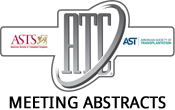2021 American Transplant Congress
CEACAM1 Signaling is Essential to Elicit Tim-3 Inhibitory Regulation in Liver Transplantation
The Dumont-UCLA Transplantation Center, Los Angeles, CA
*Purpose: T cell immunoglobulin domain and mucin domain-3 (TIM-3) has been reported to induce T cell exhaustion. By alleviating hepatic ischemia-reperfusion injury, we have explored…2021 American Transplant Congress
Evaluation of the Differentiation Program of Endogenous Antigen-specific CD8+T Cells Following Transplantation
1Pathology, Johns Hopkins University, Baltimore, MD, 2Surgery, Emory Transplant Center, Atlanta, GA
*Purpose: Despite advances in the survival of transplanted organs, acute T cell mediated rejection remains a significant clinical problem with few effective or targeted treatments.…2021 American Transplant Congress
The Importance of Persistent and Recurrent T Cell Mediated Rejection in Tacrolimus Treated Renal Transplant Recipients
*Purpose: Optimal follow-up after treatment for T-cell mediated rejection (TCMR) is not well-established. We sought to identify the prevalence and clinical associations of repeated TCMR…2021 American Transplant Congress
TIGIT Identifies Polyfunctional Donor-Specific CD4+ T Cells Lost After Kidney Transplantation
Nephrology and Transplantation, Erasmus MC, Rotterdam, Netherlands
*Purpose: Development of T-cell hyporesponsiveness to donor antigen may explain the substantial decrease in the risk for acute rejection in the years following kidney transplantation.…2021 American Transplant Congress
Single Cell RNAq-seq Analysis of Paired Peripheral and Intragraft T Cells Reveals Biopsy Specific Fc Receptor Gene Expression in Rejection Only
Washington University School of Medicine, St Louis, MO
*Purpose: Antibody mediated rejection (AMR) remains one of the major causes of allograft failure and our understanding of this disease process is poor. Transcriptomics studies…2021 American Transplant Congress
Adenovirus-Specific T Cells for Steering of Immunosuppression After Pediatric Kidney Transplantation in the Randomized Controlled Ivist Trial
*Purpose: Pharmacokinetic monitoring alone is insufficient to estimate the intensity of immunosuppression after pediatric kidney transplantation (Tx). Levels of virus-specific T cells (Tvis) have been…2021 American Transplant Congress
Establishing a Linear Program for the Development of Costimulation Resistant T-Cells
*Purpose: CD4+CD57+PD1-T-cells are primed effectors capable of mediating belatacept-resistant rejection, however, the developmental program giving rise to these cells has not been elucidated in detail.…2021 American Transplant Congress
Lymphotoxin Beta Receptor Regulates Treg Migration and Suppression by Modulating Draining Lymphatic Structure
1U Maryland, Baltimore, MD, 2Harvard U, Boston, MA
*Purpose: Regulatory T cells (Treg) must migrate from tissues via lymphatic vessels (LV) to the draining lymph node (dLN) to induce tolerance. During migration, Treg…2021 American Transplant Congress
K562 Cells Expressing HLA-A2 Stimulate Alloreactive CD8+ T Cells
Emory Transplant Center, Emory University, Atlanta, GA
*Purpose: T cell-mediated rejection is a significant factor that leads to graft damage and loss in transplant recipients. Due to the complexity of the TCR:pMHC…2021 American Transplant Congress
Double Negative T Cells Mediate Cd39-Dependent Protection in Hepatic Ischemia and Reperfusion Injury
*Purpose: Hepatic ischemia and reperfusion injury (HIRI) is a significant cause of morbidity and mortality following liver transplantation and major hepatic resections. Double negative T…
- « Previous Page
- 1
- …
- 9
- 10
- 11
- 12
- 13
- …
- 53
- Next Page »
